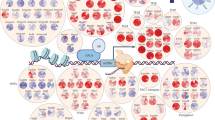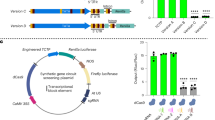Abstract
The expression levels of many genes are regulated in response to particular environmental or developmental cues. A simple regulated gene can conceptually be divided into three elements: structural components that encode the gene product, promoter elements that are essential for gene expression, and regulatory elements responsible for changing the level of expression after a specific stimulus1,2. When cells of the yeast Saccharomyces cerevisiae are subjected to amino acid starvation, his3 and many other amino acid biosynthetic genes are expressed threefold above the basal level3,4. Previously, I isolated mutations mapping outside the structural gene that severely reduce or eliminate his3 expression5,6. These mutations define two distinct his3 promoter elements located 115–155 and 32–52 base pairs (bp) from the site of transcriptional initiation. Here I describe 18 small deletion mutations, some of which express his3 at the basal level but are unable to increase the level of expression in the appropriate physiological conditions. These define two regulatory sites located 32–41 and 80–100 bp upstream from the site of transcriptional initiation, and they strongly suggest that these regions are necessary for the positive regulation of his3 expression. I consider the results in terms of models for the general control of amino acid biosynthesis.
This is a preview of subscription content, access via your institution
Access options
Subscribe to this journal
Receive 51 print issues and online access
$199.00 per year
only $3.90 per issue
Buy this article
- Purchase on Springer Link
- Instant access to full article PDF
Prices may be subject to local taxes which are calculated during checkout
Similar content being viewed by others
References
Jacob, F., Ulmann, A. & Monod, J. C.R. hebd. Séanc. Acad. Sci., Paris 258, 3125–3139 (1964).
Jacob, F. & Jacob, J. J. molec. Biol. 3, 318–356 (1961).
Wolfner, M., Yep, D., Messenguy, F. & Fink, G. R. J. molec. Biol. 96, 273–290 (1975).
Struhl, K. Cold Spring Harb. Symp. quant. Biol. 47 (Ch. 62 in the press).
Struhl, K. Proc. natn. Acad. Sci. U.S.A. 77, 1432–1436 (1981).
Struhl, K. Proc. natn. Acad. Sci. U.S.A. (in the press).
Struhl, K. & Davis, R. W. J. molec. Biol. 152, 553–568 (1981).
Donohue, T., Farabaugh, P. & Fink, G. Gene (in the press).
Struhl, K. & Davis, R. W. J. molec. Biol. 152, 535–552 (1981).
Travers, A. A. J. Bact. 141, 973–976 (1980).
Travers, A. A. J. molec. Biol. 141, 91–97 (1980).
Struhl, K. & Davis, R. W. Proc. natn. Acad. Sci. U.S.A. 74, 5255–5259 (1977).
Struhl, K. & Davis, R. W. J. molec. Biol. 136, 309–332 (1980).
Cox, B. S. Heredity 26, 211–232 (1971).
Scherer, S. & Davis, R. W. Science 209, 1380–1384 (1980).
Struhl, K. thesis, Stanford Univ. (1979).
Author information
Authors and Affiliations
Rights and permissions
About this article
Cite this article
Struhl, K. Regulatory sites for his3 gene expression in yeast. Nature 300, 284–287 (1982). https://doi.org/10.1038/300284a0
Received:
Accepted:
Issue Date:
DOI: https://doi.org/10.1038/300284a0
This article is cited by
-
Cloning, nucleotide sequence, and regulation of MET14, the gene encoding the APS kinase of Saccharomyces cerevisiae
Molecular and General Genetics MGG (1991)
-
Deletion analysis of the ARG4 promoter of Saccharomyces cerevisine: A poly(dAdT) stretch involved in gene transcription
Molecular and General Genetics MGG (1990)
-
Structure of the ARO3 gene of Saccharomyces cerevisiae
Molecular and General Genetics MGG (1988)
-
Regulation of isoleucine-valine biosynthesis in Saccharomyces cerevisiae
Current Genetics (1988)
-
The glucose- and ethanol-dependent regulation of PDC1 from Saccharomyces cerevisiae are controlled by two distinct promoter regions
Current Genetics (1988)
Comments
By submitting a comment you agree to abide by our Terms and Community Guidelines. If you find something abusive or that does not comply with our terms or guidelines please flag it as inappropriate.



